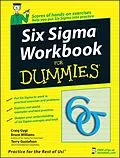Improve your efficiency -- and bring in big profits!
Need help implementing or understanding Six Sigma? Want to take
this powerful problem-solving methodology and apply it to your
business? Six Sigma isn't just for Fortune 500 companies anymore;
it's for every business, even yours, no matter how big or small.
This hands-on workbook provides the knowledge, insight, and
practical exercises you need to master Six Sigma and put it to work
in your business. Perfect as a companion workbook for Six Sigma For
Dummies -- or any other Six Sigma book -- Six Sigma Workbook For
Dummies gives you a wealth of examples, problems, and other tools
you need to turn Six Sigma theory into practice -- today!
Discover
* How to form and lead a Six Sigma initiative
* Project alignment with business objectives and strategy
* How to create process flow maps and models
* Chart and graph plotting for analysis and interpretation
* Methods for calculating Sigma scores
* How to quantify variable relationships
Autorentext
Craig Gygi is Vice President of Products and Services at Savvi International. Bruce Williams is Chairman and CEO of Savvi International. Gygi and Williams are coauthors of Six Sigma For Dummies. Terry Gustafson is COO of Savvi International.
Klappentext
- Put Six Sigma to work in practical exercises and problems
- Explore real-world examples and best practices
- Deepen your understanding of Six Sigma concepts and tools
Improve your efficiency — and bring in big profits!
Need help implementing or understanding Six Sigma? Want to take this powerful problem-solving methodology and apply it to your business? Six Sigma isn't just for Fortune 500 companies anymore; it's for every business, even yours, no matter how big or small. This hands-on workbook provides the knowledge, insight, and practical exercises you need to master Six Sigma and put it to work in your business. Perfect as a companion workbook for Six Sigma For Dummies — or any other Six Sigma book — Six Sigma Workbook For Dummies gives you a wealth of examples, problems, and other tools you need to turn Six Sigma theory into practice — today!
Discover:
How to form and lead a Six Sigma initiative
Project alignment with business objectives and strategy
How to create process flow maps and models
Chart and graph plotting for analysis and interpretation
Methods for calculating Sigma scores
How to quantify variable relationships
THE DUMMIES WORKBOOK WAY
Plain-English explanations
Step-by-step procedures
Hands-on practice exercises
Ample workspace to work out problems
Online cheat sheet
A dash of humor and fun
Get Smart!@www.dummies.com
- Find listings of all our books
- Choose from many different subject categories
- Sign up for eTips at etips.dummies.com
Zusammenfassung
Improve your efficiency -- and bring in big profits!
Need help implementing or understanding Six Sigma? Want to take this powerful problem-solving methodology and apply it to your business? Six Sigma isn't just for Fortune 500 companies anymore; it's for every business, even yours, no matter how big or small. This hands-on workbook provides the knowledge, insight, and practical exercises you need to master Six Sigma and put it to work in your business. Perfect as a companion workbook for Six Sigma For Dummies -- or any other Six Sigma book -- Six Sigma Workbook For Dummies gives you a wealth of examples, problems, and other tools you need to turn Six Sigma theory into practice -- today!
Discover
* How to form and lead a Six Sigma initiative
* Project alignment with business objectives and strategy
* How to create process flow maps and models
* Chart and graph plotting for analysis and interpretation
* Methods for calculating Sigma scores
* How to quantify variable relationships
Inhalt
Introduction.
Part I: Getting Started in Six Sigma.
Chapter 1: Getting Ready for Six Sigma: The Effects of Variation.
Chapter 2: Forming a Six Sigma Initiative.
Chapter 3: Leading and Managing a Six Sigma Initiative.
Part II: Defining a Six Sigma Project.
Chapter 4: Putting the Right Foot Forward: Defining a Six Sigma Project.
Chapter 5: Brainstorming the Inputs to Your Process.
Chapter 6: Prioritizing Which Inputs to Address.
Part III: Mastering Measuring.
Chapter 7: Categorizing Data and Calculating Measures of Variation.
Chapter 8: A Picture's Worth 1,000 Words: Measuring with Charts and Graphs.
Chapter 9: Yield and Defects: Calculating the Good, the Bad, and the Ugly.
Part IV: Assessing the Right Approach to Your Analysis.
Chapter 10: Mastering Measurement System Analysis (MSA).
Chapter 11: Capability: Matching Performance to Need.
Chapter 12: Narrowing Your Inputs with Confidence.
Part V: Improving and Controlling.
Chapter 13: Quantifying Variable Relationships.
Chapter 14: Planning and Conducting 2k Factorial Experiments.
Chapter 15: Constructing Control Plans and Charts.
Part VI: The Part of Tens.
Chapter 16: Ten Implementation Myths of Six Sigma.
Chapter 17: Ten Tips for Finishing a Six Sigma Project Successfully.
Index.
